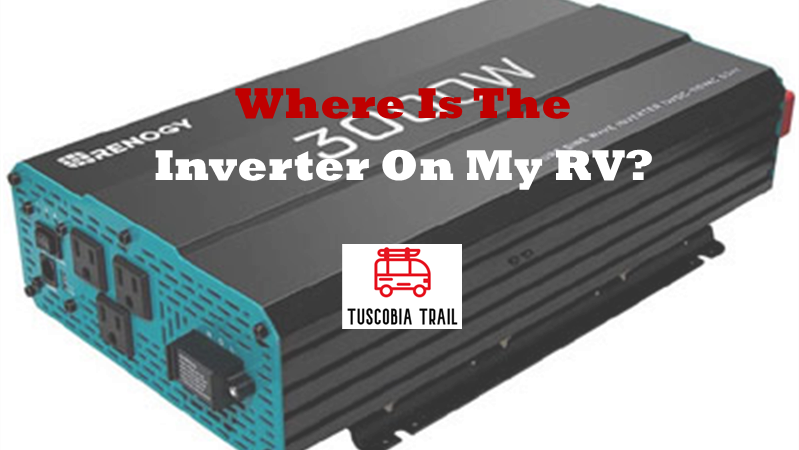Have trouble with your campervan electrics or have a new purchase and wondering where is the inverter on my RV? It’s not as daunting as you might think.
RV inverters are crucial components that convert 12V DC power from your batteries into 120V or 240V AC power, allowing you to use “normal” household appliances while off-grid.
Locating your RV’s inverter is essential for maintenance and troubleshooting, as is knowing how the electrical system actually works.
Does your RV have an inverter installed?
Not all RVs come with pre-installed inverters. If you can’t find one and your outlets only work when connected to shore power, hook up or a generator, your RV likely doesn’t have an inverter installed.
To determine if your RV has an inverter installed, you can follow these steps:
Check Your RV’s Documentation
The owner’s manual or electrical system diagram should indicate if an inverter is part of your RV’s electrical setup. If you have purchased an RV, this is the best first move to make.
Look for 120V outlets that work without shore power or generator
If you can use household appliances or electronics when not connected to external power sources, it’s likely you have an inverter.
Inspect areas near the batteries or electrical panel
Inverters are typically installed close to the RV’s battery bank to minimize voltage drop. Look for a box-like device connected to thick cables running from the batteries.
Check the basement compartment
Many RVs have their inverters installed in a basement storage area, especially near the front of the trailer.
Look for a status light or control panel
Most RV power inverters are equipped with a status light or control panel. If you find such a device, it’s likely your inverter.
Test specific outlets or appliances
Your RV’s inverter may only power certain outlets or appliances. Try plugging in a small device to outlets that are typically inverter-powered, such as those near the entertainment center or in the kitchen area.
Consult the manufacturer
If you’re still unsure, contact your RV’s manufacturer. They can provide specific information about your model’s electrical system and whether an inverter was included.
Inverter Location in an RV
Inverters are typically installed close to the RV’s battery bank to minimize voltage drop and you’ll often find them within a few feet of the batteries.
RV and van inverters generate heat, so they’re usually placed in locations with good airflow with many opting for the rear “basement” or boot compartment.
Other RVs have their inverters installed in a basement storage under the floor or near the front of the trailer if the batteries are looking under seating or in cupboard space.
You should also check close to the distribution center as some RVs have inverters installed near here for easy integration with the existing wiring.
When searching for your inverter, look for a box-like device connected to thick cables running from the batteries. In fact, it is easiest to trace from your battery in the first place.
It’s important to note that the inverter will be separate from the converter, which performs the opposite function of changing AC to DC power.
Identify Type and Model of RV Inverter
To identify the type and model of your RV inverter, you’ll need to find it first!
As mentioned earlier, the inverter is typically located near the RV’s batteries, electrical panel or in a dedicated compartment.
Once you’ve found the inverter, look for a label or nameplate on the device. This label usually contains important information such as:
- Brand name
- Model number
- Power rating (in watts)
- Input and output voltages
- Type of inverter (e.g., pure sine wave, modified sine wave)
Many inverters have a built-in control panel or display that may show the model information when powered on, giving you key information as different types of inverters have distinct characteristics.
Pure sine wave inverters are generally more expensive and efficient, modified sine wave inverters are less expensive but may not work with all appliances, while square wave inverters are rare in modern RVs due to their limited compatibility.
Check the power output as the inverter’s size (wattage) can give you an idea of its capabilities. Small inverters (300W to 1,000W) are for basic electronics, while larger ones (2,000W and above) can power more demanding appliances.
Frequently Asked Questions
How far should the inverter be from the batteries?
The inverter should be as close to the batteries as possible, typically within a few feet, to minimize voltage drop.
Can the inverter be in the same compartment as the batteries?
It depends on the battery type. For sealed batteries (Gel, AGM, Lithium Iron Phosphate), it’s safe. However, for flooded lead-acid batteries, the inverter should be in a separate compartment due to potential gas emissions.
How much ventilation does an inverter need?
Inverters require adequate airflow around them, especially near the cooling fan intake vents. We always recommend consulting your inverter’s manual for specific spacing recommendations.
Can I install an inverter myself?
While it’s possible, inverter installation involves working with high-voltage electricity. If you’re not confident in your abilities, it’s best to consult a professional.
How do I know if my RV already has an inverter?
Check your RV’s documentation or look for 120V or 240V outlets that work when not connected to shore power or a generator. You can also inspect areas near the batteries or electrical panel for a device resembling an inverter.
